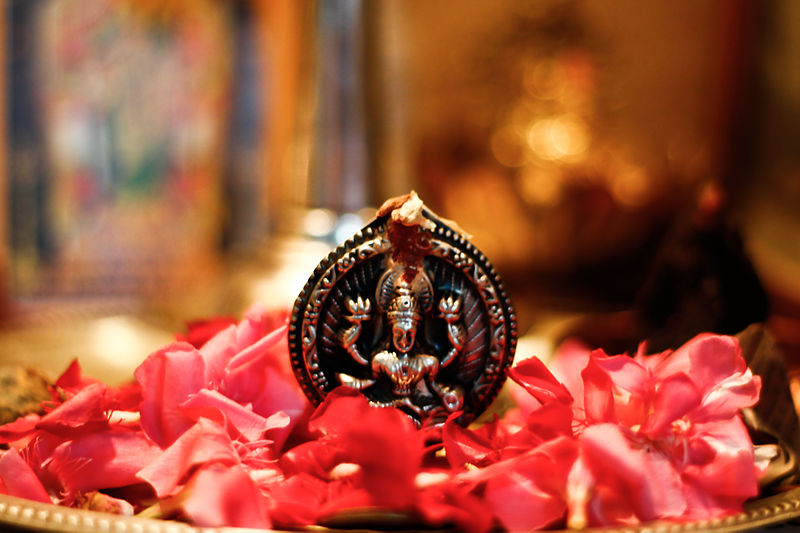In the Hindu pantheon, the mother goddess Lakshmi is a symbol of beauty, prosperity and good fortune. The wife and feminine counterpart of the god Vishnu, Lakshmi brings spiritual and material wealth and abundance to her devotees. One of the most beloved goddesses in Hinduism, Lakshmi embodies a graceful strength and a wise, gentle benevolence. Lakshmi is celebrated in India and around the world during Diwali, the festival of lights, which commemorates the triumph of light over darkness. You can cultivate Lakshmi’s qualities of easeful but directed movement toward transformation in your own meditation and yoga practice.
Lakshmi’s four hands link her to four qualities that make transformation in human life possible. One hand signifies the principles of dharma, the concept of living an ordered, directed life in accordance with cosmic laws and moral and ethical codes. Another symbolizes kāma, longing or desire for both spiritual and physical fulfillment. The third hand links her to artha, material comfort and abundance. The final hand symbolizes moksha, or self-acutalization. These four qualities are united in the goddess, making her an inspirational figure for her many followers. She is also commonly depicted with a lotus, a flower that grows out of mud and symbolizes refinement and the evolution to greater self-realization.
Lakshmi also has a fickle side. Her origin story tells of her birth from a sea of milk, at which point three male deities (Shiva, Brahma and Vishnu) all fought for her attention because of her loveliness. She is said to have had relationships with other gods, demons and races. When she is balanced by Vishnu, she becomes steadfast, inhabiting her own full power and providing support for others. Lakshmi’s balanced existence can be incorporated into your own practice in ways that will spark new discoveries and lead to greater equanimity in your mind and body.
For example, during mediation, invoke Lakshmi’s qualities by focusing your attention on the world’s support and abundance—breathe into knowing that you have everything you need right now. With eyes closed and a steady breath, listen to the fullness of the world around you: Open the windows and take in the sounds of everything, from your own heartbeat to the chirping of birds and snatches of conversation you hear on the street. Notice the richness of experience and understand yourself as part of it all. Finally, imagine the sounds and sensations you feel from the outside world entering you and becoming one with your own individual identity, which can expand and become connected to the rest of existence.
During asana, invoke Lakshmi by cultivating qualities of femininity, fertility, abundance, and gentleness. Regardless of your gender, bringing these qualities into balance is an important step on the path of living with equanimity. Lakshmi’s connection to the second, sacral chakra (located near the womb and hips) lends itself to a deep opening practice with plenty of sukha (sweetness) thrown in. Try this: Begin in Supta Baddha Konasana (Reclined Cobbler’s Pose) to gently open your hips and shoulders, experiencing the support of the earth beneath you and the opening of your own body to possibility. Rest one hand on your heart and one on your belly to connect with the qualities of fertility and open-heartedness. Move into more active poses, like downward facing dog and some classical sun salutations, to warm up. Then go into more hip opening poses, like Half and Double Pigeon (Firelog) Pose, Frog, and Happy Baby. Work your way up to Flowering Lotus and Full or Half Lotus Pose to connect with Lakshmi’s transformative potential. Feel the bounty of yourself and the world around you as move move into a deep, open Savasana.


















Leave a Reply